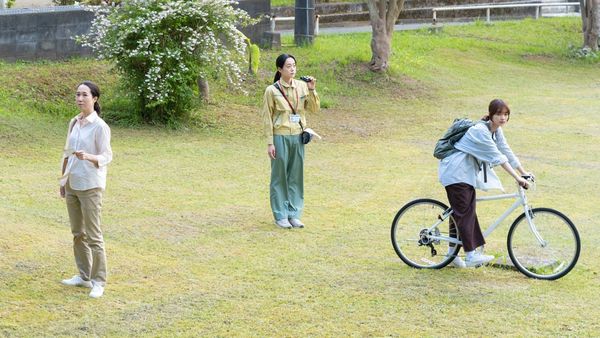Eye For Film >> Movies >> Remembering Every Night (2022) Film Review
Remembering Every Night
Reviewed by: Anne-Katrin Titze

Yui Kiyohara’s Remembering Every Night (Subete No Yoru Wo Omoidasu, a 2023 New Directors/New Films highlight) shot by Yukiko Iioka (cinematographer of the Silver Bear Grand Jury Prize winner, Ryûsuke Hamaguchi’s Wheel Of Fortune And Fantasy at the 71st Berlin International Film Festival) stars Kumi Hyodo, Minami Ohba, and Ai Mikami with Guama Uchida, Shintaro Yuya, Mizuho Nojima, and Tadashi Okuno (star of Abbas Kiarostami’s Like Someone In Love).
“It’s missing a key” is the first sentence spoken by one of the musicians whose compositions will accompany Kiyohara’s beautifully memorable Remembering Every Night. Tama New Town, a housing complex built in 1971 as a Tokyo satellite city, is where the film lets us stroll around and bike with its three female protagonists. Via these movements and the caring gaze the ordinary becomes extraordinary.

Chizu (Kumi Hyodo) is 44 and recently lost her job as a kimono dresser. This day in May when the action of the film takes place is her birthday. She spends it by going to the employment office and then rambling on to find the address of a friend who had sent her a postcard to visit her new home quite a while ago. She encounters kids who lost their shuttlecock in a tree and crosses paths, but doesn’t speak to, the other two protagonists of the film.
Sanae (Minami Ohba) at age 33 is a gas meter reader, who is gifted mandarins by a woman who tells her about the history of Tama New Town and the fact that women in the past had organized a vibrant community there to bring up their children in harmony and togetherness. Sanae subsequently is the one who accompanies an older gentleman, Mr. Takada (Tadashi Okuno), whose dementia makes him go back to a place where he doesn’t live anymore, to safety.
The third protagonist is Natsu (Ai Mikami), a student of 22, who lost a dear friend precisely a year ago. We first see her dancing in the park, while Chizo, from a distance mimics her movements. Together with a girlfriend (Guama Uchida), Natsu visits an exhibition on the Jōmon era, Japan’s Neolithic period and later that night, lights sparklers to celebrate the memory of their school friend, whose last photos were being developed by the boyfriend of Sanae, protagonist # 2.
The overlaps don’t feel forced between the three women and us, rather they are organic extensions of the place and what it could have been, which is actually one of the themes of the movie. Memories connect and even if they are not ours, they can make us understand something urgently human. A montage of toddler birthday party footage, packed with strawberry and cream cakes and baumkuchen with candles, is a reminder of a joy most of us started out with.
Maybe because while Sanae speaks about her memories with a stray cat and we see an old toy of a bus, I suddenly thought about Hayao Miyazaki’s enchanted 1988 animation My Neighbour Totoro and its spectacular cat bus, which seems to always transport to the right place at the right time.
Reviewed on: 09 Sep 2023















